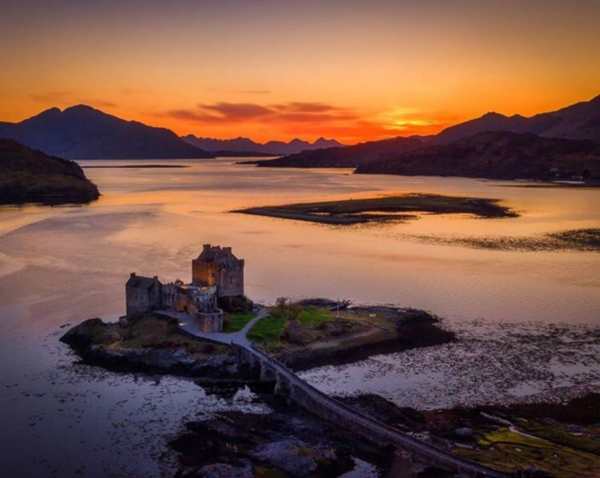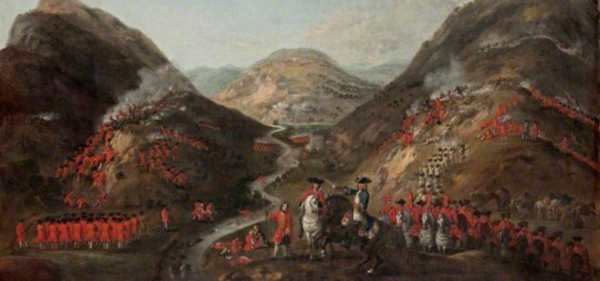Remembering the last Spanish invasion of Great Britain ... 1719
Spanish made a brave attempt to restore the exiled Stuart King James VIII and III
A quiet spot for an invasion landing in April 300 years ago! Eilean Donan Castle was subsequently destroyed when the Spaniards munitions store was hit by Royal Navy gunfire but later rebuilt.
2019 sees a major commemoration of which full details are available HERE

It's not true that Great Britain hasn't been invaded since 1066 of course. The Dutch came ashore in Torbay in 1688 to usurp King James II and VII. In 1719 it was the Spanish as here recalled. In 1789 it was the French Revolutionaries at Fishguard in Wales [recorded in a magnificent tapestry linked HERE.]
The Jacobite Rising of 1719 and the Battle of Glen Shiel
Wikipedia reports: The Battle of Glen Shiel/ Blàr Ghleann Seile took place on 10 June 1719 in the West Scottish Highlands, between a Jacobite army of Highland levies and Spanish marines and a government force of regular troops, plus a Highland Independent Company.
It was the most significant military action of the 1719 Jacobite Rebellion which resulted in a government victory that ended the rebellion. Glen Shiel is also unique as the only battle in Scotland between 1689 and 1746 where the Jacobites remained on the defensive, rather than employing the Highland Charge.
The rising was backed by Spain, then engaged in the 1718 to 1720 War of the Quadruple Alliance with Britain. Intended to support a landing in South-West England which was prevented by storms, only the Scottish segment took place and the manner of its failure was widely viewed by contemporaries as having damaged the Jacobite cause.
The battlefield is included in the Inventory of Historic Battlefields in Scotland and protected by Historic Environment Scotland since 2011. The mountain where the battle took place is called Sgurr na Ciste Duibhe and has a subsidiary peak named Sgurr nan Spainteach or 'Peak of the Spaniards' in honour of the Spanish marines who fought there.
Marquess of Tullibardine, Jacobite commander at Glen Shiel
The 1719 Rising was a Spanish-backed attempt to divert British resources from the Mediterranean; the plan was for 7,000 Spanish troops to land in South-West England, march on London and restore King James Stuart. A simultaneous rising in Scotland was to capture Inverness, allowing a Swedish expeditionary force to disembark; this was due to Sweden's dispute with Hanover and an example of the complexity caused by its ruler George I being British monarch.
In the event, only George Keith and 300 Spanish soldiers reached Stornoway in the Isle of Lewis on board two Spanish frigates. They were joined by a group of exiles from France, including the Earl of Seaforth, James Keith, the Marquess of Tullibardine, Lord George Murray and Cameron of Lochiel. On 13 April, they learned of failure elsewhere; as commander of Jacobite land forces, Tullibardine recommended retreat, but as commander of the two frigates, Keith prevented this by ordering them back to Spain.
With no other option, the main force now of around 1,000 Highlanders plus the Spanish troops prepared to march on Inverness, leaving their excess stores at Eilean Donan guarded by 40 Spaniards. On 10 May, a British naval squadron captured the castle, blocking any escape by sea, while Joseph Wightman's force of around 1,000 men with four Coehorn mortars advanced towards Glen Shiel. On 9 June, they reached Loch Cluanie, less than 8 miles (13 km) from the Jacobite camp.[a]
The battle of Glen Shiel
Tullibardine prepared a strong position near the Five Sisters hills, with the Spanish in the centre and the Highlanders on the flanks behind a series of trenches and barricades. Wightman's force arrived about 4:00 pm on 10 June and began the attack an hour later by firing their mortars at the Jacobite flanking positions. This caused few casualties but the Scots had not encountered mortars before, allowing four platoons of Clayton's and Munro's to advance up the hill to their lines, then use grenades to bomb them out of their positions.

Once the Jacobite right had been dislodged, Harrison and Montague attacked the Jacobite left under Lord Seaforth. This was strongly entrenched behind a group of rocks on the hillside but skilful use of the mortars forced Seaforth's men to give way while he himself was badly wounded. The Spanish in the centre stood their ground but had to withdraw up the mountain as their flanks gave way.
The battle lasted until 9:00 pm; several accounts claim the heather caught fire and smoke combined with failing light enabled the bulk of the Scots to disappear into the night. The Spanish surrendered next morning and as regular troops were shipped home; Lord George Murray, Seaforth and Tullibardine were wounded but the Jacobite leaders also managed to escape.
Analysis attributes Wightman's victory to skilful use of mortars, the superior firepower of his grenadiers and the aggression shown by his infantry, especially the Munro Independent Company.
Jacobite casualties were hard to estimate since few bodies were left on the field and the wounded managed to escape, including Seaforth and Lord George Murray; Wightman lost 21 killed and 120 wounded. Lord Carpenter, commander in Scotland, advised London that pursuing the rebels was impractical and it was best to let them go, arguing the Rising had simply damaged the Jacobite cause. Tullibardine concurred; in his letter of 16 June 1719 to the Earl of Mar he provides a description of the battle and states 'it bid fair to ruin the King's Interest and faithful subjects in these parts.'
The government took Carpenter's advice and for many Jacobites this was the end; even senior exiles like Bolingbroke, Seaforth and Lord Murray returned home, while George and James Keith both resumed their military careers in Europe and ended their lives as Prussian generals.
________________________________________________________________
TERCENTENARY COMMEMORATION DETAILS IN SUMMARY
Association of Highland Clans and Societies [AHCS], 5/3 North Charlotte Street, Edinburgh, EH2 4HR
Secretary: Mrs Anne Maclean of Dochgarroch:
Tel: 0778 946 3992 . Email: highlandclans@aol.com
The AHCS, in conjunction with the Clan MacKenzie Society and the 1745 Association, is ensuring commemoration of the Battle of Glenshiel on the above dates. The programme is to foster the Kinship, Friendship and Fellowship of the Clan system.
Saturday June 8th: You will leave Inverness by coach from the Mercure Hotel for Kintail where a guided tour of Eilean Donan Castle is booked for you, you will have the opportunity to enjoy the beautiful setting, tea toom and shop at the Castle and also to take time to view the exclusive exhibition by the NTS archealogist in the nearby Dornie Hall where there will also be rolling talks on the history of the Battle. Your coach will again be accompanied by a knowledgeable guide for the journey.
In the afternoon you will be taken by coach to the Battle Site where you will commemorate the 300th Anniversary of the Battle of Glen Shiel, after which you will return to Inverness by coach.
All expenses are included apart from lunch which can be purchased in the Castle tea rooms.
Saturday 8th Evening. Come to socialise at the Clan MacKenzie ceilidh in the Mercure Hotel where you can catch up with friends old and new.
Sunday 9th June: Kirkin o’ the Tartans service and a chance to say your farewells.
Book with Jenn Scott at glenshiel1719@gmail.com and tell her if you have paid by BACS …. or send a booking form with your cheque to- Jenn Scott, The Stewart Society, 53, George Street, Edinburgh, EH2 2HT
Published Date: May 29th 2019
|





